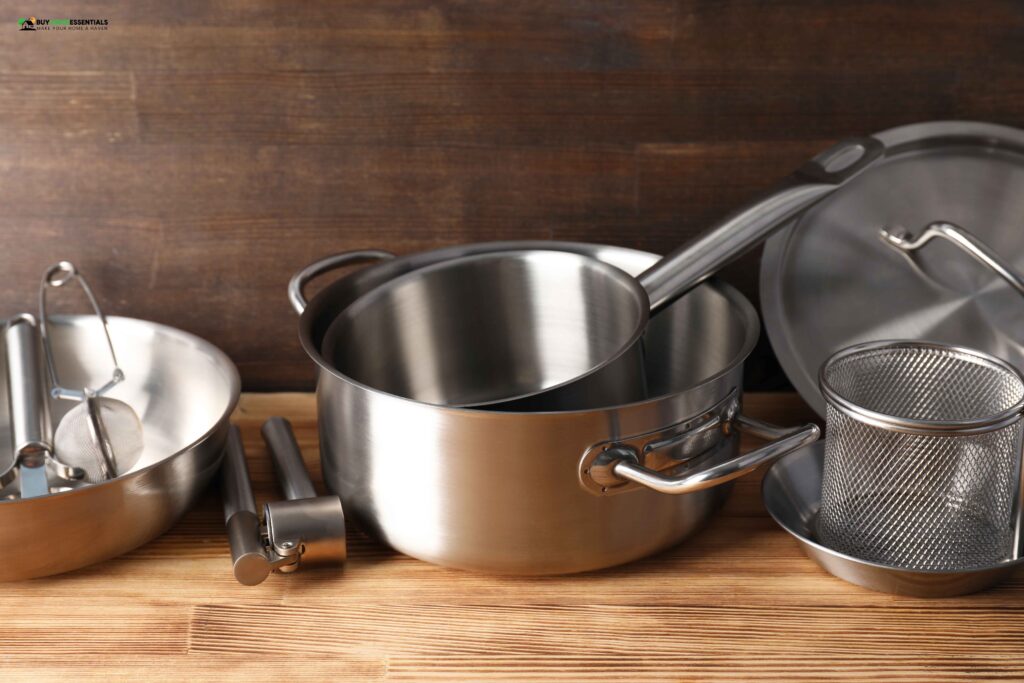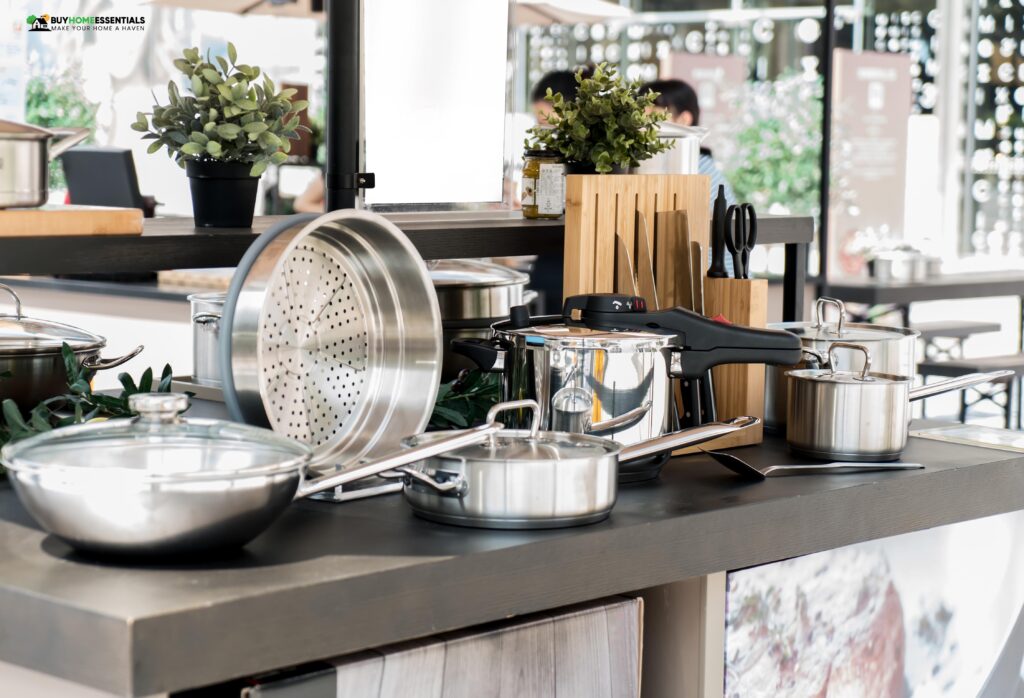Cookware is the cornerstone of any kitchen, affecting both quality and ease of cooking. Choosing the suitable pots and pans often boils down to the material – aluminum vs stainless steel cookware. Each has its advantages and drawbacks, so weigh your options carefully.
This blog post will explore the essential differences between aluminum and stainless steel cookware. Knowing their unique properties and how they affect your cooking will help you make the right choice. Let’s get started.
What is Aluminum Cookware

Aluminum cookware is a popular choice since it’s lightweight and highly conductive. It’s made of pure aluminum or aluminum alloys with copper or stainless steel added to ensure even heat distribution.
Home cooks and professionals appreciate its lightweight design, making handling and carrying pots and pans effortless. The affordability and practicality of aluminum cookware have made it a staple in kitchens worldwide.
Advantages of Aluminum Cookware
Aluminum cookware presents several advantages contributing to its widespread popularity among cooks of all levels. Here are the key benefits of aluminum cookware:
Lightweight and Easy to Handle
Aluminum is known for its lightweight nature, making cookware easy to handle and carry. People who want kitchen utensils that are easy to use, especially with bigger pots and pans, will appreciate this feature.
Excellent Heat Conductivity
The heat conductivity of aluminum is one of the best among metals used in cookware. It heats quickly and evenly, providing precise temperature control and efficient cooking. The property ensures uniform cooking – no hot spots or undercooked spots.
Affordable Option for Home Cooks
Compared to other materials like stainless steel or copper, aluminum cookware is generally more affordable. Cost-effectiveness makes it an appealing choice for people setting up their kitchen or expanding their cookware collection.
Related: How to Clean Aluminum Pots
Disadvantages of Aluminum Cookware
While aluminum cookware has its advantages, it also comes with some drawbacks that need to be considered before making a purchase:
Reactivity with Acidic and Alkaline Foods
A significant disadvantage of aluminum cookware is its reactivity to acidic and alkaline foods. When aluminum reacts with acidic ingredients like tomatoes or citrus leaches into the food, it may affect the dish’s taste and, in excessive amounts, could pose health concerns.
Durability Concerns
Despite its relatively soft nature, aluminum cookware can scratch or dent easily. Warping and pitting can occur over time, especially if you cook with high heat. Therefore, it may require more frequent replacement than materials with a longer lifespan.
What is Stainless Steel Cookware

The durability and versatility of stainless steel cookware make it a popular choice. It’s made from a blend of metals, primarily iron, carbon, and a minimum of 10.5% chromium. As a result of this composition, the cookware is corrosion-resistant and resistant to tarnish.
Due to its non-reactive nature, stainless steel is a preferred choice for maintaining the taste and quality of food. Additionally, it is easy to clean, non-porous, and can withstand high cooking temperatures, making it suitable for many cooking methods.
Advantages of Stainless Steel Cookware
Cookware made from stainless steel boasts several advantages that make it a popular choice among chefs and home cooks. These are some of the key benefits of stainless steel cookware:
Durability and Longevity
Stainless steel cookware is known for its exceptional durability and longevity. It’s made to withstand high temperatures without warping or deteriorating. Over time, the cookware keeps its quality and appearance, making it a long-term investment.
Non-reactive with Foods
Since stainless steel is a non-reactive material, it will not react with acidic or alkaline foods. By doing so, you can ensure that the taste and color of your food will remain unchanged. So the natural flavors of your dishes won’t be compromised by metallic taste or smell.
Versatility in Cooking Styles
The versatility of stainless steel cookware makes it ideal for various cooking methods. Stainless steel cookware is excellent for sautéing, frying, boiling, simmering, or baking. Due to its ability to distribute heat evenly, you can control the cooking process precisely.
Easy to Maintain and Clean
Stainless steel cookware is easy to maintain. The dishwashing machine is dishwasher-safe, saving time and effort in the kitchen. Also, stainless steel doesn’t react with detergents, so regular cleaning keeps the cookware in good shape. You can easily remove stubborn stains or burnt residue using gentle scrubbing and soaking.
Related: How to Clean Stainless Steel Pan
Attractive Appearance
Cookware made of stainless steel has a sleek, modern appearance that complements any kitchen style. Its shiny and polished surface adds a professional touch to your cooking space. Stainless steel maintains its luster after repeated uses, making it an aesthetically pleasing and functional choice.
Resistant to Corrosion and Rust
Stainless steel is highly corrosion and rust-resistant due to its chromium content. As a result, it is ideal for long-term use without fear of quality deterioration. Stainless steel cookware can withstand moisture and acidic foods without losing its integrity.
Disadvantages of Stainless Steel Cookware
Although stainless steel cookware has many advantages, it also has some limitations. The main disadvantages of stainless steel cookware are as follows:
Poor Heat Conductivity
The heat conductivity of stainless steel is not as good as that of aluminum or copper. The cookware’s surface may develop hot spots, resulting in uneven heating and affecting the quality of your cooking.
High Price Point
Compared to other types of cookware, stainless steel can be relatively expensive. The higher cost is often due to the quality of materials and the cookware’s durability.
Learning Curve for Cooking
Compared with cookware with better heat conductivity, stainless steel requires some learning curve to use effectively. You may need time to adjust and understand how to manage and distribute heat evenly.
Aluminum vs Stainless Steel Cookware: Which is Better

Understanding the distinctive characteristics of aluminum and stainless steel cookware is essential to making an informed decision. With its excellent heat conductivity, aluminum cookware ensures even cooking and precise temperature control, so it’s perfect for various dishes. However, aluminum is reactive, especially with acidic and alkaline foods, so it might affect the taste.
In contrast, stainless steel cookware is durable and long-lasting and doesn’t conduct heat either. Due to its resistance to scratching and denting, it is a long-term investment. In addition to being non-reactive, stainless steel ensures your dishes retain their natural flavors without tasting metallic. People who prefer lightweight cookware may find it disadvantageous because it is heavier than aluminum.
Your choice ultimately depends on your cooking style, desired heat distribution, durability, reactivity with foods, and kitchen comfort.
FAQs
Which is better, aluminum or stainless steel for cooking?
The choice depends on priorities. Aluminum offers excellent heat conductivity and is lightweight, ideal for precise cooking. However, it can react with certain foods. On the other hand, stainless steel is durable, non-reactive, and resilient.
Whether you prioritize efficient heat distribution (aluminum) or durability and non-reactivity (stainless steel) in your cooking utensils is a matter. Consider your cooking style and needs to determine the best fit for your kitchen.
What is healthier, aluminum or stainless steel?
In terms of health, stainless steel is considered safer. During cooking, aluminum cookware may react with acidic or alkaline foods, potentially transferring metal into the meal. While aluminum exposure poses health risks, stainless steel, being non-reactive, ensures no such interaction, making it a safer cooking option. However, ensuring proper use and maintenance can mitigate any potential health risks.
Is it safe to cook in stainless steel?
Stainless steel cookware is generally safe to use. The non-reactive nature of stainless steel makes it a good choice for cooking utensils. Stainless steel doesn’t leach harmful substances into food, so everything you cook will be safe and suitable.
Be sure to follow manufacturer instructions, avoid overheating, and use the proper cooking utensils to prevent scratching or damaging the cookware. Overall, stainless steel cookware is safe and reliable when used correctly.
Is aluminum better than non-stick?
The answer depends on your preferences and cooking needs. The heat conductivity of aluminum cookware is excellent, but it requires oils or fats to prevent food from sticking. On the other hand, non-stick cookware requires little oil, making it a healthier option.
Note that non-stick coatings can wear off over time and at high temperatures, releasing harmful fumes. When choosing cookware, consider your cooking style, health concerns, and maintenance preferences.
Which cookware is best for health?
For optimal health, stainless steel and cast iron cookware are often considered the best choices. Stainless steel is non-reactive and does not leach harmful chemicals into food. Cast iron can add small amounts of dietary iron to your meals if correctly seasoned and maintained.
Both materials are durable and can withstand high temperatures, making them excellent options for health-conscious cooks. Moreover, you should avoid overheating any cooking vessel and use non-toxic utensils to maintain the health benefits.
Conclusion
Choosing between aluminum and stainless steel cookware comes down to priorities. Aluminum distributes heat efficiently and is lightweight, so it’s perfect for precise cooking. Some foods may react with it, though.
Stainless steel, on the other hand, is durable, non-reactive, and lasts longer. Both materials can elevate your culinary endeavors and make cooking a pleasure when used correctly. In the end, you should make a decision based on your cooking style and preferences.





